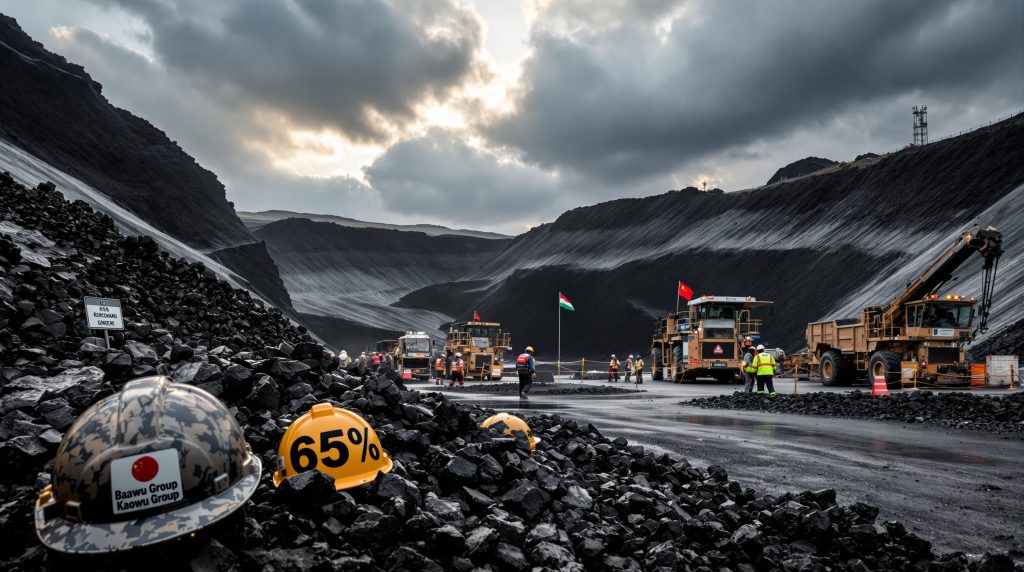Guinea Iron Ore Mine Tragedy: Understanding the Fatal Accident and Its Impact
The Simandou iron ore project in Guinea faces a critical operational pause following a devastating workplace accident. On October 2, 2025, three foreign workers lost their lives at the Kerouane mine site, prompting immediate suspension of all operations by the Winning Consortium Simandou (WCS). This tragic incident has raised significant questions about workplace safety in Guinea's expanding mining sector while potentially impacting global iron ore market trends.
What Happened at the Simandou Iron Ore Mine in Guinea?
The fatal Guinea iron ore mine accident occurred on October 2, 2025, at the Kerouane mine site, part of the massive Simandou iron ore project in Guinea. According to Bloomberg News reports, three foreign workers died in what company officials described as a workplace incident, though specific details about the nature of the accident remain undisclosed pending investigation.
Following the tragedy, the Winning Consortium Simandou took immediate action by suspending all operations at the site. This rapid response aligns with standard industry protocol following fatal accidents, allowing for comprehensive safety reviews and thorough investigation.
Timeline of the Tragic Event
- October 2, 2025: The fatal accident occurred at the Kerouane mine site
- Immediate aftermath: Emergency protocols activated with medical personnel attempting life-saving measures
- Same day: Full suspension of operations announced by WCS management
- Current status: Mining activities remain halted pending completion of safety investigation
Emergency medical personnel were deployed promptly to the scene, but despite their efforts, they were unable to save the three workers. The specific circumstances surrounding the incident remain unclear as investigators work to determine the cause.
Safety Response Measures
The consortium immediately implemented a series of response measures following the accident:
- Complete cessation of all mining operations at the Kerouane site
- Activation of emergency response protocols according to company safety guidelines
- Deployment of medical response teams to the accident site
- Initiation of comprehensive safety procedure review across all operational areas
- Clear commitment that operations will resume only after thorough safety assessment
Mining safety experts note that such immediate operational suspensions are standard industry practice following fatal accidents. This allows for proper investigation while demonstrating the company's commitment to preventing similar tragedies in the future.
Who Operates the Simandou Iron Ore Project?
The Simandou iron ore deposit is being developed through a complex international partnership structure with significant Chinese investment backing.
Key Project Stakeholders
The primary operator of the project is the Winning Consortium Simandou (WCS), which holds development rights for Blocks 1 and 2 of the massive Simandou deposit. This consortium receives substantial financial and technical backing from China's Baowu Group, recognized as one of the world's largest steel producers with annual crude steel production capacity exceeding 130 million tonnes.
The partnership represents a significant Chinese investment in Guinea's mineral resources sector, highlighting China's strategic interest in securing high-quality iron ore supplies for its domestic steel industry. This reflects broader trends of Chinese investment in African mining operations over the past decade.
Project Significance and Scale
The Simandou deposit stands among the world's largest untapped high-grade iron ore reserves, making it strategically important for global steel production:
- The project is expected to produce premium iron ore with approximately 65% iron content, significantly higher than many existing operations
- When fully developed, production capacity is projected to reach 120 million tonnes annually
- The iron ore quality at Simandou is particularly valuable for steelmakers seeking to reduce carbon emissions through higher-grade inputs
- The project represents a cornerstone investment in Guinea's mineral development strategy and national economic growth
Industry analysts highlight that Simandou's development has faced numerous challenges and delays over the years, including legal disputes, infrastructure requirements, and changing ownership structures. Despite these obstacles, the project has continued to advance with significant investment commitments.
Why Is This Accident Significant for Guinea's Mining Industry?
This tragic Guinea iron ore mine accident carries broader implications for Guinea's rapidly expanding mining sector, potentially affecting investment climate and regulatory approaches.
Mining Safety Context in Guinea
Guinea has emerged as a significant player in the global mining industry evolution due to its vast mineral wealth:
- The country possesses substantial reserves of bauxite (approximately 7.4 billion tonnes, representing around 26% of global reserves)
- Gold deposits throughout the country have attracted numerous international mining companies
- The Simandou iron ore project represents one of the world's largest untapped iron ore deposits
- Manganese, diamond, and other mineral resources further enhance Guinea's mining potential
However, the mining industry in Guinea has faced ongoing scrutiny regarding working conditions and safety standards. While comprehensive statistical data on mining accidents in the country remains limited, industry observers note that safety practices vary significantly across operations, with some sites implementing international best practices while others face challenges in maintaining rigorous safety protocols.
Economic Implications
The accident occurs at a critical juncture for Guinea's mining-based economic development strategy:
- The mining sector currently contributes approximately 35% of Guinea's GDP and over 80% of export earnings
- Foreign investment in mining has been a cornerstone of economic growth strategies
- Safety incidents can potentially impact investor confidence in Guinea's mining sector
- Regulatory responses to the accident could affect operational timelines for major projects
- The country's reputation as a mining investment destination may be influenced by how effectively authorities and companies address safety concerns
Mining industry experts suggest that the government's response to this incident will be closely watched by international investors considering future projects in Guinea. A transparent investigation followed by meaningful safety improvements could actually strengthen confidence in the regulatory environment.
What Safety Challenges Do Mining Operations Face in Guinea?
Mining in Guinea presents unique operational challenges that can impact worker safety across the industry.
Common Safety Risks in Iron Ore Mining
Iron ore mining operations worldwide face several inherent safety risks that require rigorous management:
- Heavy equipment accidents: Large mining vehicles and machinery present significant hazards
- Rock falls and structural collapses: Underground and open-pit operations face stability challenges
- Transportation incidents: Moving materials across mining sites creates numerous risk points
- Environmental factors: Heat, dust, limited visibility, and seasonal weather conditions compound risks
- Remote location challenges: Distance from medical facilities can complicate emergency response
These universal mining risks can be exacerbated in developing regions where infrastructure, emergency services, and training programs may still be evolving to meet international standards.
Industry-Wide Safety Considerations
Several factors specifically affect safety outcomes in Guinea's mining sector:
- Training and qualification requirements: Ensuring workers receive adequate safety training presents ongoing challenges
- Regulatory oversight capacity: Guinea's mining regulatory bodies continue to develop inspection and enforcement capabilities
- Emergency response infrastructure: Remote mining locations may have limited access to advanced medical facilities
- Communication barriers: Language and cultural differences between international management and local workforce can complicate safety instruction
- Implementation of global standards: Adapting international best practices to local conditions requires thoughtful implementation
Mining safety professionals emphasize that successful safety programs must address both technical hazards and human factors, including proper training, clear communication protocols, and a strong safety culture throughout the organization.
How Will This Accident Impact the Simandou Project Timeline?
The suspension of operations following the fatal accident will inevitably affect the development schedule of this strategically important iron ore project.
Project Development Status
Prior to this incident, the Simandou project had been advancing after years of delays, similar to other major projects like the Onslow iron project halt in Australia:
- The Winning Consortium Simandou had been focused on developing Blocks 1 and 2 of the deposit
- Construction activities were underway to build essential infrastructure including processing facilities
- Initial production was reportedly targeted to begin by late 2025 or early 2026
- The accident creates uncertainty regarding adherence to this timeline
- Regulatory investigations could potentially extend the operational pause
The project also faces the complex challenge of developing transportation infrastructure, including a 650-kilometer railway line connecting the mine site to a dedicated port facility.
Potential Consequences for Project Schedule
Several factors will determine the extent of delay resulting from this incident:
- Investigation duration: Thorough safety investigations typically require weeks or months to complete
- Implementation of corrective measures: Any identified safety improvements will require time to implement
- Regulatory review processes: Government authorities may require extensive documentation and verification before allowing operations to resume
- Workforce considerations: Additional safety training or procedural changes may be necessary before full operations can restart
Industry observers note that while safety pauses are essential following fatal accidents, companies with strong safety cultures often emerge with more robust processes that enhance long-term operational performance.
What Does This Mean for Global Iron Ore Markets?
The Simandou development represents a significant potential addition to global iron ore supply, meaning any substantial delay could influence market dynamics.
Market Significance of Simandou
The Simandou project holds substantial importance for global iron ore markets:
- When fully developed, Simandou could produce approximately 120 million tonnes of high-grade iron ore annually
- This volume represents roughly 8% of current global seaborne iron ore trade
- The premium quality (65% iron content) is particularly valuable for modern steelmaking processes
- The project is widely viewed as one of the most significant new iron ore developments globally
The addition of such a large volume of high-grade iron ore would significantly impact global supply dynamics, potentially influencing iron ore price forecast 2025 and market structure.
Short-term Market Impact
Market analysts suggest several potential outcomes from the current situation:
- Limited immediate price effect: Since Simandou was not yet in production, the immediate impact on iron ore pricing should be minimal
- Investor sentiment: The incident may raise questions about project timelines and future supply availability
- Heightened focus on safety: Other major development projects worldwide may face increased scrutiny regarding safety practices
- Reassessment of supply forecasts: Market analysts may adjust medium-term supply projections if significant delays appear likely
For iron ore consumers, particularly Chinese steelmakers who would likely be major customers for Simandou's output, any substantial delay in the project could influence strategic planning for future raw material sourcing, with implications for iron ore demand insights.
What Safety Improvements Might Result From This Incident?
Fatal accidents often catalyze significant safety reforms across the mining industry, potentially leading to improved practices and regulations.
Potential Safety Enhancements
The investigation into this Guinea iron ore mine accident will likely identify specific areas for improvement:
- Strengthened emergency response capabilities: Enhanced medical facilities, equipment, and evacuation protocols
- Expanded safety training programs: More comprehensive instruction for both local and international workers
- Implementation of advanced monitoring systems: Technologies to detect potential hazards before accidents occur
- Improved communication systems: Better hazard reporting mechanisms across language and cultural barriers
- Greater investment in preventative maintenance: Ensuring equipment reliability to reduce failure-related incidents
Mining safety professionals note that significant incidents often lead to the identification and implementation of previously overlooked safety measures that benefit not only the affected operation but potentially the broader industry.
Regulatory Responses
Government authorities typically review and potentially enhance oversight following fatal mining accidents:
- Increased inspection frequency: More regular site visits by safety regulatory personnel
- Enhanced reporting requirements: More detailed documentation of safety incidents and near-misses
- Updated safety regulations: Potential revisions to mining safety codes and standards
- Stricter enforcement measures: Potentially increased penalties for safety violations
- Improved investigative capabilities: Enhanced technical resources for accident investigations
Effective regulatory responses balance the need for stringent safety standards with practical implementation considerations, recognizing that overly burdensome requirements can sometimes have unintended negative consequences.
FAQ: Guinea Iron Ore Mine Accident
What is known about the victims of the Simandou accident?
The three workers who lost their lives were identified as foreign nationals working at the Kerouane mine site. Specific details regarding their nationalities, roles, and the circumstances of their deaths have not been publicly disclosed pending the investigation and notification of families. Mining operations often employ both local and international workers, particularly for specialized technical roles.
How common are fatal accidents in Guinea's mining sector?
While comprehensive statistics are limited, Guinea's rapidly expanding mining sector has experienced several serious safety incidents in recent years. The country's regulatory framework for mining safety continues to evolve as the industry grows. International mining safety experts note that developing mining jurisdictions often face challenges in establishing robust safety systems as their industries expand rapidly.
Will this accident affect Guinea's other mining operations?
The incident may prompt broader safety reviews across Guinea's mining sector, potentially leading to temporary disruptions as companies reassess their safety protocols. Regulatory authorities may also increase inspection activities at other mining operations. This could particularly impact sites with similar operational profiles or those operated by the same companies involved in the Simandou project.
What is the expected timeline for resuming operations?
No specific timeline has been announced for restarting operations at the Kerouane mine site. The Winning Consortium Simandou has stated that activities will resume only after a comprehensive safety review is completed and they can provide assurances that appropriate safety measures are in place. Similar incidents in other mining operations have resulted in operational pauses ranging from weeks to months, depending on investigation findings.
How might this affect Guinea's economic development plans?
Guinea's economic strategy relies heavily on developing its mineral resources, with mining representing approximately 35% of GDP. While this incident may cause temporary delays at Simandou, the long-term economic importance of the project means development will likely continue with enhanced safety measures. Government officials remain committed to advancing mining projects while ensuring proper safety standards are maintained.
Balancing Development and Safety in Guinea's Mining Sector
The tragic accident at the Simandou iron ore project underscores the critical importance of maintaining rigorous safety standards in mining operations, particularly in regions experiencing rapid industrial development. As Guinea continues to develop its substantial mineral resources, balancing economic growth with worker safety remains a paramount concern.
The investigation into this incident will likely yield valuable insights that could strengthen safety practices not only at Simandou but potentially across Guinea's entire mining sector. While the immediate focus remains on understanding what occurred and preventing similar tragedies, the long-term implications may include enhanced safety standards, improved emergency response capabilities, and greater regulatory oversight.
For the families of those lost, no safety improvements can compensate for their loss. However, ensuring that lessons are learned and implemented may help prevent future tragedies as Guinea continues to develop its natural resources.
The Simandou project will eventually move forward, given its strategic importance to both Guinea's economic development and global iron ore markets. However, this pause provides an opportunity to strengthen safety systems and ensure that when production eventually begins, it does so with the highest possible protection for workers.
Disclaimer: This article contains analysis of a developing situation. Facts and circumstances may change as investigations progress and more information becomes available. Readers should consult multiple sources for the most current information.
Want to Stay Ahead of Major Mining Discoveries?
Discover potentially market-moving mineral announcements before the crowd with Discovery Alert's proprietary Discovery IQ model, delivering real-time notifications on significant ASX mineral discoveries. Explore historic returns of major discoveries and their market impact at Discovery Alert's discoveries page to gain your investment edge today.




